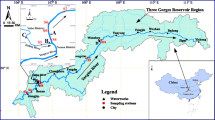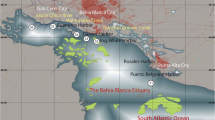Abstract
Comprehensive studies to determine the level of predisposition of Saudi environment to many micro-contaminants are scanty. To improve on the available literature, an attempt was made here to determine concentrations of six species of organotins in water samples collected from 17 coastal sites in the Eastern Province of Saudi Arabia. These sites were grouped into three sampling stations: Near Dammam Corniche, King Abdulaziz Port (Inside), and King Abdulaziz Port (Outskirts). The samples were extracted using solid-phase extraction and then derivatized by propylation using Grignard reagent. Analytes were separated and quantitatively determined on gas chromatography–mass spectrometric system using selected ion monitoring mode. Recoveries for 0.1 μ g L−1 spiked sea water samples were between 81 and 89 %, and limits of detection of 5.2–11 ng/L were estimated at S/N = 3. Total organotin concentration found at each station was averaged at 3.70 μ g L−1. The individual species detected and quantified as the butylated species were tributyltin (0.14–1.9 μ g L−1), dibutyltin (0.11–0.70 μ g L−1), and monobutyltin (0.13–1.5 μ g L−1). For the phenylated tins, triphenyltin (0.12–1.9 μ g L−1), diphenyltin (0.21–1.9 μ g L−1), and monophenyltin (0.11–0.62 μ g L−1) were determined in the samples. These determinations had %RSD of 6.1–11.5 % for the different analytes. Using ratios of tributyltin and triphenyltin to their respective degradation products, fresh input of these micro-contaminants into the marine environment was inferred.
Similar content being viewed by others
References
Sousa, A.; Ikemoto, T.; Takahashi, S.; Barroso, C.M.; Tanabe, S.: Distribution of synthetic organotins and total tin levels in Mytilus galloprovincialis along the Portuguese coast. Mar. Pollut. Bull. 58, 1130–1136 (2009)
Sousa A.C.A., Oliveira I.B., Laranjeiro F., Takahashi S., Tanabe S., Cunha M.R., Barroso C.M.: Organotin levels in Nazaré canyon (west Iberian Margin, NE Atlantic) and adjacent coastal area. Mar. Pollut. Bull. 64, 422–426 (2012)
Nemanic T.M., Leskovsek H., Horvat H., Vriser B., Bolje A.: Organotin compounds in the marine environment of the Bay of Piran, Northern Adriatic Sea. J. Environ Monit. 4(3), 426–430 (2002)
Antizar-Ladislao B.: Environmental levels, toxicity and human exposure to tributyltin (TBT)-contaminated marine environment. A review. Environ. Int. 34, 292–308 (2008)
Sousa A.C.A., Pastorinho M.R., Takahashi S., Tanabe S.: History on organotin compounds, from snails to humans. Environ. Chem. Lett. 12, 117–137 (2014)
Blaber S.J.M.: The occurrence of a penis-like growth behind the right tentacle in spent females of Nucella lapillus (L). Proc. Malacol. Soc. Lond. 39, 231–233 (1970)
Bryan, G.W.; Gibbs, P.E.; Hummerstone, L.G.; Burt, G.R.: Copper, zinc and organotin as long-term factors governing the distribution of organisms in the Fal Estuary in southwest England. Estuaries 10, 208–219 (1987)
Bryan, G.W.; Gibbs, P.E.; Hummerstone, L.G.; Burt, G.R.: The decline of the gastropod Nucella lapillus around south-west Eng land: evidence for the effect of tributyltin fromantifouling paints. J. Mar. Biol. Assoc. UK 66, 611–640 (1986)
Oliveira I.B., Richardson C.A., Sousa A.C., Takahashi S., Tanabe S., Barroso C.M.: Spatial and temporal evolution of imposex in dogwhelk Nucella lapillus (L.) populations from North Wales, UK. J. Environ. Monit. 11, 1462–1468 (2009)
Smith, B.S.: Sexuality in the American mud snail, Nassarius 401 obsoleius Say. Proc. Malacol. Soc. Lond. 39, 377–378 (1971)
Shi H.H., Huang C.J., Zhu S.X., Yu X.J., Xie W.Y.: Generalized system of imposex and reproductive failure in female gastropods of coastal waters of mainland China. Mar. Ecol. Prog. Ser. 304, 179–189 (2005)
Bryan G.W., Gibbs P.E., Hummerstone L.G., Burt G.R.: The decline of the gastropod Nucella lapillus around south-west England: evidence for the effect of tributyltin from antifouling paints. J. Mar. Biol. Assoc. UK 66, 611–640 (1986)
Alzieu C.: Tributyltin: Case study of a chronic contaminant in the coastal environment. Ocean Coast Manag. 40, 23–36 (1998)
Alzieu C., Sanjuan J., Deltriel J. P., Borel M.: Tin contamination in Arcachon Bay: Effects on oyster shell anomalies. Mar. Pollut. Bull. 17, 494–498 (1986)
Gibbs P.E., Pascoe P.L., Burt G.R.: Sex change in the female dog-whelk, Nucella lapillus, induced by tributyltin from antifouling paints. J. Mar. Biol. Assoc. UK 68, 715–731 (1988)
Gibbs P.E.: A male genital defect in the dog-whelk, Nucella lapillus (Neogastropoda), favoring survival in a TBT-polluted area. J. Mar. Biol. Assoc. UK 73, 667–678 (1993)
Alzieu C., Sanjuan J., Michel P., Borel M., Dreno J.P.: Monitoring and assessment of butyltins in Atlantic coastal waters. Mar. Pollut. Bull. 20, 22–26 (1989)
Magos, L.: Tin. In: Friberg, L., Nordberg, G.F., Vouk, V. (eds.) Handbook on the Toxicology of Metals (2nd ed), pp. 568–593. Elsevier, New York (1986)
Sadiki A.-I., Williams D.T.: A study on organotin levels in Canadian waters distributed through PVC pipes. Chemosphere 38, 1541–1548 (1999)
Wax P.M., Dockstader L.: Tributyltin use in interior paints: a continuing health hazard. J. Toxicol. Clin. Toxicol. 33, 239–241 (1995)
EPA: National Recommended Water Quality Criteria. http://water.epa.gov/scitech/swguidance/standards/criteria/current/index.cfm (Accessed on 1 Dec 2014)
Zabaljauregui M., Delgado A., Usobiaga A., Zuloaga O., de Diego A., Madariaga J.M.: Fast method for routine simultaneous analysis of methylmercury and butyltins in seafood. J. Chromatogr. A 1148, 78–85 (2007)
Wahlen R., Catterick T.: Comparison of different liquid chromatography conditions for the separation and analysis of organotin compounds in mussel and oyster tissue by liquid chromatography-inductively coupled plasma mass spectrometry. J. Chromatogr. B 783, 221–229 (2003)
Bravo M., Lespes G., De Gregori I., Pinochet H., Gautier M.P.: Determination of organotin compounds by headspace solid-phase microextraction–gas chromatography–pulsed flame-photometric detection (HS-SPME–GC–PFPD). Anal. Bioanal. Chem. 383, 1082–1089 (2005)
Centineo, G.; Rodriguez-Gonzalez, P.; Gonzalez, E.B.; et al.: Iso tope dilution GC-MS routine method for the determination of butyltin compounds in water. Anal. Bioanal. Chem. 384, 908– 914 (2006)
Panggabean A.S., Amran M.B., Achmad S.: Speciation of organotin compounds with ion pair-reversed phase chromatography technique. Eurasian J. Anal. Chem. 4, 215–225 (2009)
Wasik A., Radke B., Bolalek J., Namiesnik J.: Optimisation of pressurized liquid extraction for elimination of sulphur interferences during determination of organotin compounds in sulphur-rich sediments by gas chromatography with flame photometric detection. Chemosphere 68, 1–9 (2007)
Kannan K., Takahashi S., Fujiwara N., Mizukawa H., Tanabe S.: Organotin compounds, including butyltins and octyltins, in house dust from Albany, New York, USA. Arch. Environ. Contam. Toxicol. 58, 901–907 (2010)
Neng N.R., Santalla R.P., Nogueira J.M.F.: Determination of tributyltin in environmental water matrices using stir bar sorptive extraction with in-situ derivatisation and large volume injection-gas chromatography-mass spectrometry. Talanta 126, 8–11 (2014)
Zuliani T., Lespes G., Milacic R., Scancar J.: Development of the extraction method for the simultaneous determination of butyl-, phenyl- and octyltin compounds in sewage sludge. Talanta 80, 1945–1951 (2010)
The National Ambient Water Quality Standard for KSA. http://www.pme.gov.sa/en/En_EnvStand20.pdf. Accessed on 1 Dec 2014
EPA: Surface water sampling-Field Sampling Guidance Document # 1225. Richmond, California. http://www.epa.gov/region6/qa/qadevtools/mod5_sops/surface_water_sampling/general/r9surface-wtr-sampling.pdf. Accessed on 2 Dec 2014
Bancon-Montigny C., Lespes G., Potin-Gautier M.: Organotin survey in the Adour–Garonne basin. Water Res. 38, 933–946 (2004)
Watanabe N., Sakai S., Takatsuki H.: Examination for Degradation Paths of Butyltin Compounds in Natural Waters. Water Sci. Technol. 25, 117–124 (1992)
Fargasova A.: The effects of organotin compounds on growth, respiration rate, and chlorophyll a content of Scenedesmus quadricauda. Ecotoxicol. Environ. Saf. 37, 193–198 (1997)
Pain A., Cooney J.J.: Characterization of organotin-resistant bacteria from Boston Harbor sediments. Arch. Environ. Contam. Toxicol. 35, 412–416 (1998)
Kuritz T., Wolk C.P.: Use of Filamentous Cyanobacteria for Biodegradation of Organic Pollutants. Appl. Environ. Microbiol. 61, 234–238 (1995)
Cleary J.J., Stebbing A.R.D.: Organotin in the surface microlayer and subsurface waters of southwest England. Mar. Pollut. Bull. 18, 238–246 (1987)
Hasan M.A., Juma H.A.: Assessment of tributyltin in the marine environment of Bahrain. Mar. Pollut. Bull. 24, 408–410 (1992)
Furdek M., Vahcic M., Scancar J., Milacic R., Kniewald G., Mikac N.: Organotin compounds in seawater and Mytilus galloprovincialis mussels along the Croatian Adriatic Coast. Mar. Pollut. Bull. 64, 189–199 (2012)
Ikeda K.T., Minami M., Yamada H., Koyama J., Kagaku K.: Bioaccumulation of organotin compounds through the food web developed in the deep water of the Japan Sea. J. Environ. Chem. 12, 105–114 (2002)
Tessier, E.; Amouroux, D.; Donard, O.F.X.: Volatile organotin compounds (butylmethyltin) in three European estuaries (Gironde, Rhine, Scheldt). Biogeochem- istry 59(1-2), 161–181 (2002)
Michel P., Averty B.: Contamination of French coastal waters by organotin compounds: 1997 update. Mar. Pollut. Bull. 38(4), 268–275 (1999)
Gomez-Ariza J.L., Morales E., Giraldez I.: Spatial distribution of butyltin and phenyltin compounds on the Huelva coast (southwest Spain). Chemosphere 37, 937–950 (1998)
Chau Y.K., Maguire R.J., Brown M., Yang F., Batchelor S.P., Thompson J.A.J.: Occurrence of butyltin compounds in mussels in Canada. Appl. Organomet. Chem. 11, 903–912 (1997)
Shim W.J., Yim U.H., Kim N.S., Hong S.H., Oh J.R., Jeon J.K.; et al.: Accumulation of butyl- and phenyltin compounds in starfish and bivalves from the coastal environment of Korea. Environ. Pollut. 133, 489–499 (2005)
Rodriguez-Gonzalez P., Encinar J.R., Alonso J.I.G., Sanz-Medel A.: Contamination of the coastal waters of Gijon on (NorthWest Spain) by butyltin compounds. Water Air Soil Pollut. 174, 127–139 (2006)
Thomaidis N.S., Stasinakis A.S., Gatidou G., Morabito R., Massanisso P., Lekkas T.D.: Occurrence of organotin compounds in the aquatic environment of Greece. Water Air Soil Pollut. 181, 201–210 (2007)
Basheer C., Tan K.S., Lee H.K.: Organotin and Irgarol-1051 contamination in Singapore coastal waters. Mar. Pollut. Bull. 44, 697–703 (2002)
Cho H.-S., Lam N.H., Lee J.S., Seol S.-W.: Organotins pollutions in seawater and sediment around a shipyard. Toxicol. Environ. Health Sci. 6, 33–40 (2014)
Ohji M., Arai T., Midorikawa S., Harino H., Masuda R., Miyazaki N.: Distribution and fate of organotin compounds in Japanese coastal waters. Water Air Soil Pollut. 178, 255–265 (2007)
Arnold C.G., Berg M., Muller S.R., Dommann U., Schwarzenbach R.P.: Determination of organotin compounds in water, sediments, and sewage sludge using perdeuterated internal standards, accelerated solvent extraction, and large-volume-injection GC/MS. Anal. Chem. 70, 3094–3101 (1998)
Author information
Authors and Affiliations
Corresponding author
Rights and permissions
About this article
Cite this article
Al-shatri, M.A., Nuhu, A.A., Basheer, C. et al. Assessment of Tributyltin and Triphenyltin Compounds and Their Main Degradation Products in Saudi Coastal waters. Arab J Sci Eng 40, 2959–2967 (2015). https://doi.org/10.1007/s13369-015-1673-2
Received:
Accepted:
Published:
Issue Date:
DOI: https://doi.org/10.1007/s13369-015-1673-2




